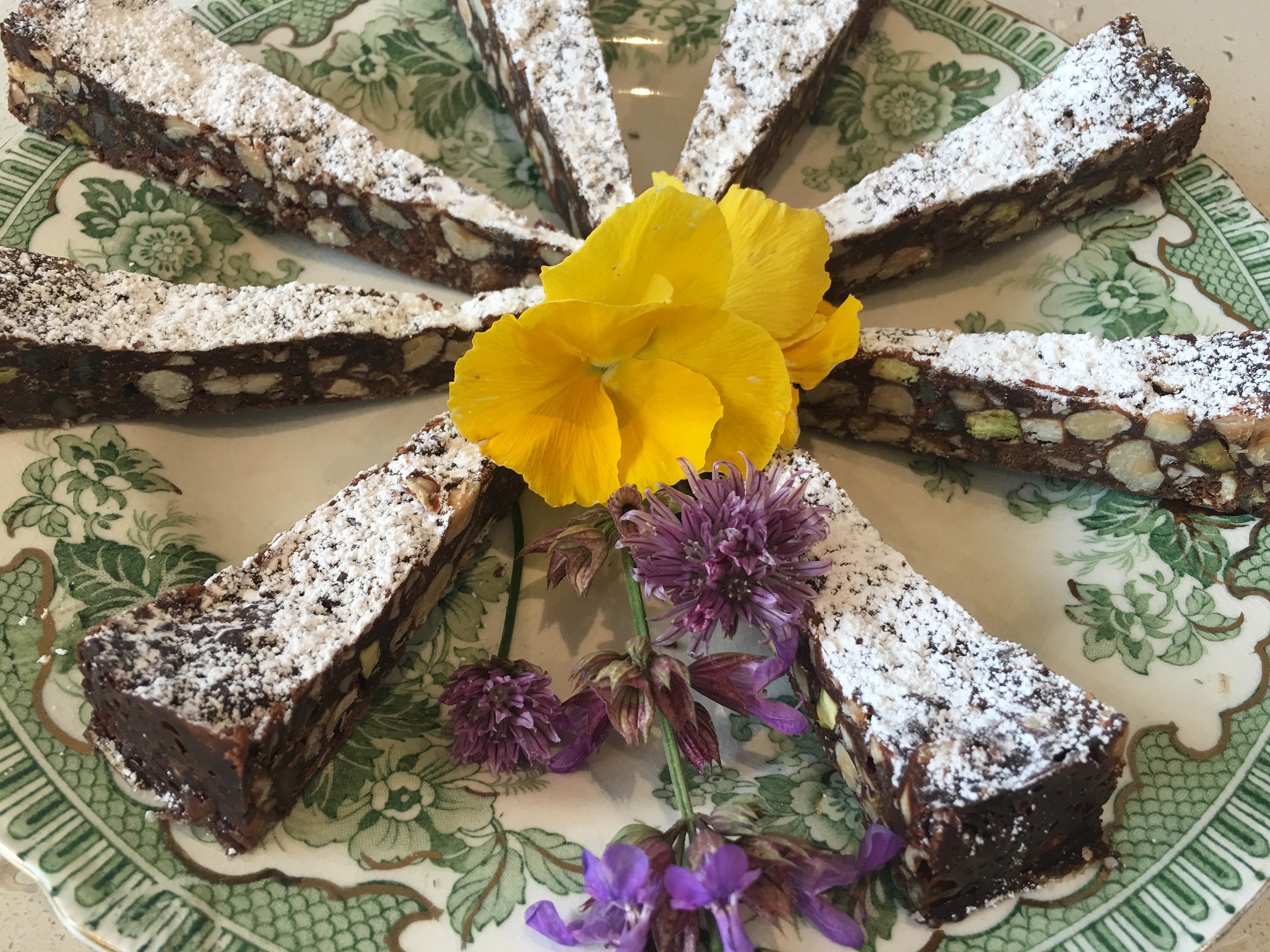Panforte, also called Siena cake, is a delicious Italian Christmas fruit, nut, chocolate, dense, chewy, candy-like cake, which hails from Siena, Tuscany. It is very much a favourite of mine and I make it every Christmas. Stored well it can last for months, but it is usually eaten well before that! It makes a wonderful Christmas gift wrapped in clear cellophane with ribbons, tinsel and Christmas balls.
Although a sugar thermometre is not essential, it makes the making of this cake so much easier.
| Ingredients | |
| 125g toasted and coarsely chopped hazelnuts
120g toasted, coarsely chopped blanched almonds 170 g candied citrus – citron, lemon and/or orange peel 1 tsp ground cinnamon ¼ tsp allspice 65g all-purpose flour or almond flour |
1 tbsp unsweetened cocoa powder
90g semi-sweet chocolate, chopped 130g granulated white sugar 160ml, ⅔ cup, honey
Garnish A dusting with icing sugar |
Butter and line a 20 cm spring-form cake tin with baking paper. Or for a more authentic look, line the pan with edible rice paper, available at Asian markets. I just use baking paper.
In a large bowl combine the nuts, candied fruit, spices, flour, and cocoa powder. Set aside.
Melt the chocolate in a stainless steel bowl placed over a saucepan of simmering water. Set aside.
In a saucepan, stir together the sugar and honey. Place the saucepan over medium heat, stirring until the sugar has dissolved and then bring to a boil.
Clamp a candy thermometer to the side of the saucepan. Continue to simmer the mixture over medium heat, without stirring, until the temperature reaches the soft ball stage, 116° C.
Remove from heat and stir the sugar and honey syrup and the melted chocolate into the chopped nut and fruit mixture. The mixture will stiffen quickly so once combined, transfer to the prepared pan. With damp hands, or the back of a spoon or offset spatula, evenly spread the Panforte, smoothing the top.
Bake in a 150°C oven for about 30 – 35 minutes or until the surface has fine blisters. Remove from oven and place on a wire rack to cool.
While the Panforte is still warmish, gently remove the sides of the pan and heavily dust the top of the cake with confectioners’ or powdered/icing sugar. Gently rub the sugar into the cake. (Note: if you have lined the pan with rice paper you may find it has torn. If that is the case simply add more rice paper, using a little egg white as glue.)
Once the cake has completely cooled, wrap tightly in plastic wrap, or place in an air-tight container, and store in a cool, dry place. Well wrapped this cake will keep several months. If it is very hot, I sometimes store it in the fridge.
Serve this cake in thin wedges as it is quite rich, ‘forte’, so it requires a good, sharp knife for the slicing.
About Panfort
Although it does have some similarities to the ‘British’ fruit cake, containing the traditional fruit, nuts, and spices, its texture and flavour are very different. Panforte is quite chewy from mixing the fruit, nuts, spices, and just a little flour to bind the ingredients, with the boiled syrup made from sugar and honey. This sugar/honey syrup, along with the addition of melted chocolate and cocoa powder, gives this Christmas cake an almost candy-like texture and flavour which is hard to resist, even for those who normally dislike fruit cake.
Traditionally Panforte is baked in a round pan that has been lined with communion wafers, to make it easier to remove, and this seems to indicate there was once a religious connection. Panforte does date from the 12th century and, although stories differ, most agree that Nuns, hence the use of communion wafers, were the first to make this delicious cake. For most of us communion wafers can be difficult to find!!
Fortunately, edible rice paper, available from most Asian markets, makes an excellent alternative. Baking paper is also a good solution.
Another distinctive characteristic of this cake is the dusting of the top of the cake with confectioners’ or powdered/icing sugar. This gives it a very festive ‘snowy’ look which adds to the holiday mood. Although this cake was once made only during the Christmas season, its popularity has now made it a year round favourite.
Making this recipe is fairly easy, the only difficult part is making of the sugar syrup. A good candy thermometer will help with that. Once the honey and sugar are boiled to the soft ball stage, 240°F or 115°C, it is poured over the rest of the ingredients. At this point you need to work quickly before the mixture stiffens and becomes difficult to spread in the pan.
Traditionally this cake was made with almonds but hazelnuts and macadamia nuts are excellent as well. Although I have used candied lemon and orange peel, you can use other candied fruits or even dried fruits, such as cranberries, cherries, pears or apricots, especially if you want to make this cake off season when candied fruits are difficult to find.
Some people like their Panforte very spicy so, if you prefer it that way, go ahead and add some white or black pepper, about ½ to 1 tsp.
Also, cocoa and chocolate were not found in the Panforte made by the Nuns. It wasn’t until the 1800s that these ingredients were used and today you can find Panforte both with and without chocolate.
Panforte is like other fruit cakes in that it stores well. So you can store it away in the cupboard and cut off a sliver any time of the year that your sweet tooth beckons.






